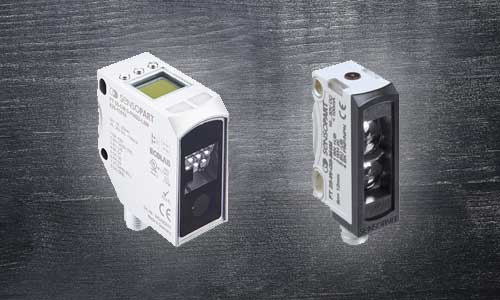Contrast Sensor [How It Works, Adjusting, Features and Applications]
A contrast sensor also known as a color mark or registration mark sensor is a high-performance device used to detect differences between two colors based on the measurement of the amount of light to detect and compare the difference in the wavelength of the reflected light by the target.
These colors are usually target color and background color. The sensor differentiates between grayscale values, enabling them to detect the smallest changes and contrasts at the highest of process line speeds.
Contrasts arise when surfaces have bright and dark areas. The state of the sensor's output changes is usually in the middle of the way between the target colors and the background color’s reflected light values.
Contrast sensors often use focused light beams including white light, laser-generated red light, and RGB (Red, Green, Blue) technology, during the teaching-in procedure.
Red, green, or blue light is emitted from the transmitter and the receiver of the sensor evaluates the process of detecting the brightness or level of light received from the target provided to the sensor.
The optimal emitted color light source is automatically chosen for an application based on target and background color. For better performance, most contrast sensors use color-variable LEDs, which allow the detection of very small contrasts.
Contrast sensors operate on the principle of energetic reflection principle and distinguish gray-scale differences on matt, shiny or transparent surfaces and objects and are available in different spot sizes ranging from a few millimeters up to 25 mm.
Browse our wide selection of Contrast Sensor products category with the highest quality.

The best kind of these sensors are the ones that provide a white light source with a broad spectrum. They create a good distinction in all colors and backgrounds and also enable rapid change in production by adjusting the threshold level to the level previously determined.
Some specialized contrast sensors offer large light spots that allow measuring the contrast at long distances up to 300 mm.
For example, the assortment of boxes from the conveyor belt is one of the applications of this kind of sensor. These sensors are capable of detecting the slightest contradiction even at high speeds and even on transparent or metal bodies, etc.
How does the contrast sensor work?
When a contrast sensor passes the teaching-in point between the background and the mark, it quickly detects it and indicates the exact position of the mark.
Contrast Sensors are used for the accurate positioning of objects in printing machines, packaging factories, and labeling machines in the food, beverage, and pharmaceutical industries.
Short response time, low contrast resolution, and a high degree of switching reliability is the characteristic of this sensor.
Adjusting the contrast sensor
The sensor should usually be installed inclined by 5° to 20° to the object surface, especially when the glossy material is scanned.
When scanning edges, grooves, or indentations, the sensor should be installed aligned; direct reflection can be detected when entering the indentation, groove, or edge to the beam of light.
Features and Advantages of contrast sensor
- Reliable performance, even with shocking nets and glossy materials.
- High accuracy that improves packaging quality
- Simple integration in machines due to compact design
- Interchangeable lenses for maximum installation flexibility
- wide range of sensing distances
- longer operating life due to having no contact with the target object
- stainless steel housing
- High grayscale resolution
- high Switching frequency
- Fast response time combined with small spot size allows for high-speed operation
Contrast sensor application
- Detection of black and white on packaging and printing machines
- Color print marks can be detected even with low contrast and reflective surface.
- Check the closure of the bottle cap.
- Confirmation of having adhesive tape on carton seals
- Identification of date/lot code, bar code, expiration date, or other printed information on containers or large codes printed on tablet bottles.
- Control the small marks on the motor shafts to control the speed
- Detection of the presence of a plastic wrapper placed over a pharmaceutical bottle cap
- Verify the leaflet is inserted into a carton.
- Confirmation of the presence of the insert in the lid
- Differentiate between the brown cardboard of the boxes and the glossy clear wrap over the boxes.
- Confirmation of the right place of the wrap-around label and properly aligned on a container
- Used in packaging lines, beverage and bottling lines, paper and printing machinery, and ceramics printing.
On the following link, we suggest you to check out hue motion sensor.
We recommend the following articles for your consideration:
Color Sensor [Working Principle, Feature, Industries and Applications]
Why you Need to Use a UV Intensity Meter
Laser Sensor [Working Principle, Types, Features, Applications]
Recent Posts
-
Booster Pump Troubleshooting and Maintenance: How to Fix and Prevent Common Issues
1. Introduction Imagine turning on your faucet only to be greeted with a weak trickle of water when …22nd Apr 2025 -
Energy-Efficient Booster Pumps: Selection and Tips for Maximizing Performance
1. Introduction Imagine never having to deal with fluctuating water pressure, noisy pumps, or skyroc …19th Apr 2025 -
Booster Pumps for Sustainable Water Systems: Irrigation and Rainwater Harvesting Solutions
1. Introduction Water scarcity is no longer a distant threat—it’s a reality affecting millions …16th Apr 2025

![Contrast Sensor [How It Works, Adjusting, Features and Applications] Contrast Sensor [How It Works, Adjusting, Features and Applications]](https://cdn11.bigcommerce.com/s-sgprcd6/images/stencil/1193x795/uploaded_images/contrast-sensor.jpg?t=1655974290)


